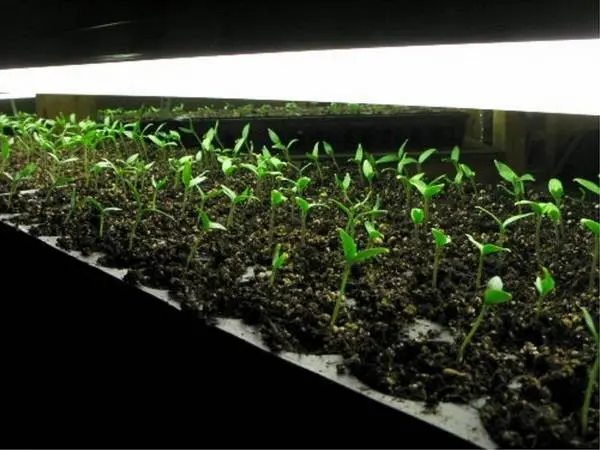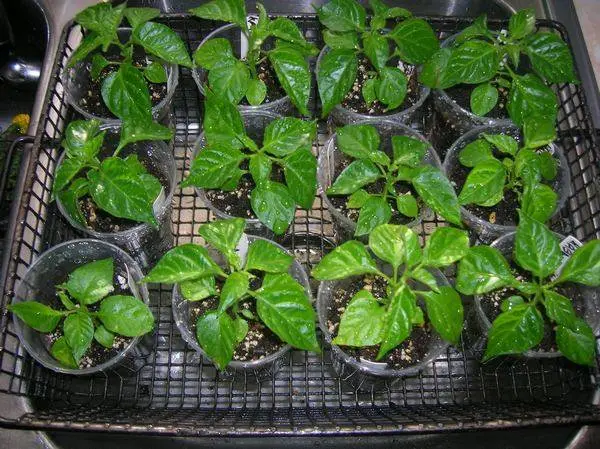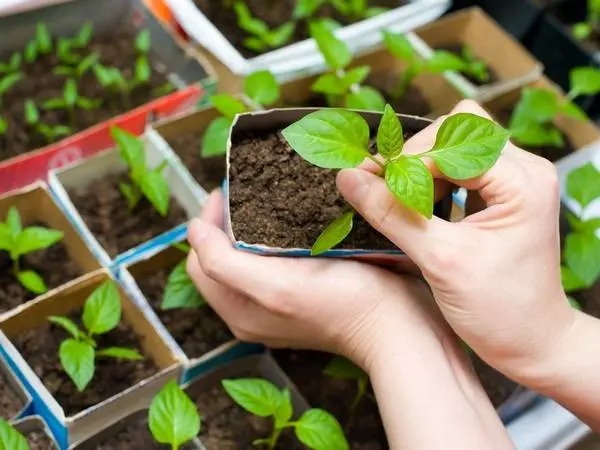Contents
Bulgarian pepper and eggplant are often grown side by side: in neighboring beds or in the same greenhouse. These cultures have a lot in common:
- demanding care;
- high frequency of watering;
- love for nutrient soils;
- the same time for sowing seeds;
- approximately equal fruit ripening time;
- The most important factor is warmth.

This similarity allows you to simultaneously grow pepper and eggplant seeds for seedlings. How to do it right and get a high yield next season – in this article.
What are the steps the seeds need to go through?
Many summer residents and experienced gardeners have a negative experience of growing pepper and eggplant seedlings on their own. As a rule, these cultures give poor germination, do not like picking very much, and slowly adapt to a permanent place. As a result, the gardener loses most of the seedlings, which affects the yield of vegetables.

To reduce the loss of seedlings, you must follow all the recommendations and do not skip any of the steps below. So, seedlings of pepper and eggplant need to be planted in several stages:
- Determining the timing of sowing seeds.
- Selection of seed material.
- Preparing containers for seedlings.
- Mixing soil for seedlings.
- Processing and hardening of seeds.
- Germination of seeds.
- Planting seeds in the ground.
- Waiting for shoots.
- Care of young seedlings.
- Pick (if needed).
- Hardening seedlings before planting in a permanent place.
- Transferring seedlings to beds or to a greenhouse.

Calculation of the date of sowing seeds
To correctly determine the time of sowing seeds for seedlings, you need to know the ripening time of the selected variety, as well as the climatic features of the region. Basically, the growing season of bell peppers is from 90 to 140 days, for eggplant this time is slightly longer – 100-150 days.

In the southern regions of Our Country, seedlings of peppers and eggplant, most gardeners take out to the ground in early May, for the middle zone – this is the middle or end of May. In the north and in the Urals, heat-loving peppers and eggplants are most often grown in greenhouses or greenhouses, but there are varieties suitable for the climate of these regions. In this case, it is necessary to transfer the seedlings to the beds no earlier than the beginning of June, when the air temperature stabilizes and the threat of night frosts disappears.
Considering that sprouts from pepper and eggplant seeds appear on the 8-15th day after sowing, it is possible to calculate the approximate time for planting seedlings – this is the end of February or the beginning of March. It was during this period that gardeners and summer residents of most of Our Country fill the window sills of their apartments with boxes of vegetable seedlings.

Selection and preparation of seeds for planting
First of all, the gardener must decide on the variety of pepper or eggplant. If this is not the first experience of growing seedlings on your own, in principle, you can choose any variety.

And for those who are just trying to grow their seedlings, it is better to buy seeds of the most unpretentious varieties of pepper and eggplant. Usually, such varieties do not have high yields or outlandish fruits – as a rule, these are the most common, average, crops. But these plants tolerate transplantation much better, are not so whimsical in care, and provide a low but stable yield.

Experienced gardeners are well aware of all the rules for growing seedlings of each crop, and for beginners, comprehensive information about this is indicated on the seed packaging. A good agricultural company is easy to calculate from the information on the seed packaging, there should be:
- the timing of the ripening of pepper or eggplant;
- landing scheme;
- recommended soil;
- temperature limits;
- information about the endurance and yield of the variety;
- data on disinfection and other seed treatments.
Having decided on the seeds, you can proceed to the next stage – processing. As a rule, expensive seeds of proven agricultural companies have already gone through all the necessary preparations for planting. This can be verified by looking at the information on the packaging, and some companies color the processed seed material or seal the seeds in colored capsules, like glaze.

When the seeds were collected by the summer resident from their own last year’s harvest, all preparatory measures must be performed in the following sequence:
- Soak the seeds in a one percent solution of manganese, 20-30 minutes is enough. After that, pepper seeds and eggplant are washed under a stream of cold water. This procedure is aimed at disinfecting the seed material.
- Improving the germination of pepper and eggplant seeds is facilitated by special growth stimulants. You can prepare such a mixture yourself: zinc, manganese, sulfate and boric acid, ammonium molybdate. The seeds are placed in this composition for a couple of days, after which they are washed and dried.
- Pickling is usually carried out in an industrial setting. In fact, this is the application of pesticides (granules or powder) to the seeds.
- Hardening is necessary for absolutely all eggplant and pepper seeds, otherwise the plants of these heat-loving crops will die with a sharp drop in ambient temperature. You need to harden the seeds in several stages, alternately placing them in heat and on the top shelf of the refrigerator. The time of each procedure is 10-12 hours, the number of temperature drops is about four.
These measures contribute to better germination, rapid seeding, and rapid growth of seedlings.
Germination of seeds
Growing seedlings of eggplant and pepper will be more effective if the seeds germinate before planting in the ground. This stage will take only a few days (from 3 to 5), but the result will be much better.

For germination, pepper and eggplant seeds are placed on a damp cotton cloth or cotton pads. It is not recommended to use gauze or a bandage for this purpose, since fragile sprouts often cling to a mesh of threads and break.
It is not necessary to pour too much water on the fabric – pepper and eggplant seeds should not float, it is enough to keep the fabric or cotton wool constantly moist.

Preparing containers for seedlings and filling them with soil
As mentioned earlier, it is better to immediately grow seedlings of peppers and eggplants in individual pots – these plants do not tolerate picking. From these considerations peppers and eggplants are rarely grown in large boxes, the most suitable containers for them are small plastic pots.

The diameter of the pot for bell pepper seedlings is 4 cm, for eggplants you need larger containers – about 5 cm.
To further reduce the risk of damage to pepper and eggplant seedlings during transplantation, the seeds of these crops can be sown in peat pots. Such seedlings are transferred to the ground along with a container – peat decomposes in the ground, without preventing the growth of roots.

As for the soil for peppers and eggplants, one thing can be said – these crops love light and crumbly soils rich in nutrients and oxygen. Each experienced gardener has his own “recipe” for preparing the substrate for seedlings of these whimsical plants. The most successful of them are mixtures:
- sod land, sand, humus;
- peat, humus, sawdust;
- garden soil, manure humus;
- sod land, peat, vermiculture.

The prepared substrate must be disinfected; the best way is to calcinate the soil in the oven. You can treat the soil with special antibacterial agents.
Prepared containers for peppers and eggplants are filled with a substrate, pouring a layer of no more than 7 cm. The earth is shed with settled warm water with the addition of manganese and left for 10-12 hours.
Seeding of seeds
Germinated seeds should be sown immediately after being removed from a damp cloth. Two grooves are made in the soil of each cup. Their depth should be about 1 cm, and the distance between them should be at least two centimeters. It is better to plant two seeds at once in each container, later, when there are three true leaves on each plant, the weaker sprout must be removed.

Seeds are carefully placed in the ground and sprinkled with the substrate. There is no need to tamp the ground, pepper and eggplant seeds love air. It is also not necessary to water newly sown seeds, they should have enough first watering for not 4-5 days.
It is better to cover the containers with plastic wrap or glass. This helps to retain moisture and maintain the temperature inside the cups with seeds.

To germinate, peppers and eggplant need a temperature of about 28 degrees, so for the first few days it is necessary to keep containers with seeds in a very warm place.
As soon as the first shoots appear, the film must be removed, otherwise the plants will turn yellow and disappear.

Seven days after germination, the temperature must be reduced to 23 degrees. During this period, the seedlings of eggplant and peppers form the root system. After 5 days, you can return to the previous temperature regime.
Care of seedlings

Caring for peppers and eggplants is quite difficult – these crops require constant attention to themselves. Therefore, at the stage of growing seedlings, the gardener needs:
- pour plants about once every five days. At the same time, at first it is better to do this with a spray bottle or a teaspoon so as not to blur the ground near the tender sprouts. Subsequently, watering can be done with a watering can, trying not to pour water on the leaves. Seedlings behind glass can get sunburned by water droplets. For watering seedlings of eggplant and pepper, you need to use soft water, boiled or settled. The ideal option is melt or rain water.
- Seedlings of pepper and eggplant love nutrient soilsThese plants need regular fertilization. To stimulate the growth of seedlings and the growth of green mass, it is necessary to fertilize it with nitrogen compounds.
- If there is not enough sunlight, peppers and eggplants need illuminate artificially. To do this, use lamps installed at a distance of 15 cm from the plants. They are turned on for 10-12 hours a day, the rest of the time the seedlings should “sleep”, it is covered with a thick cloth, and the lamps are turned off.
- Must be endured temperature condition. In the daytime, the room should be about 25 degrees, and at night the temperature should be reduced to 15 degrees. This will help the eggplants and peppers get used to the natural conditions that await them in the garden.
- Seedlings start ventilatewhen there are three true leaves on the stems. First, a window is opened on that window, near which containers with eggplants and peppers are located. Then the plants can be taken out to the loggia or balcony. After 10-14 days, they begin to take out the seedlings to the street, gradually increasing the time of her stay in the fresh air. 10 days before transplanting seedlings to beds, young peppers and eggplants should calmly withstand the whole day in the fresh air.
- Eggplant and pepper seedlings need to be prepared for planting. 10-12 hours before this, the plants are abundantly watered with warm water. It is better to transplant on a cloudy day or do it in the evening when the heat subsides.

Additional recommendations
No matter how hard gardeners try to grow decent seedlings, there is always a risk of making a mistake. In the case of pepper and eggplant, even a small oversight can be fatal – these plants are too tender.

Experienced farmers advise:
- Avoid drafts.
- Arrange containers with seedlings on the southeast and southwest window sills.
- Create high humidity in the room using household humidifiers or a wet towel on the battery.
- Every 3-4 days, turn the cups with eggplant and pepper around its axis – so that the plants are evenly illuminated by the sun, their stems do not lean in one direction.
Compliance with all the rules and recommendations will help novice gardeners grow their seedlings. And this will save you from buying low-quality pepper and eggplant plants, help you transplant in the shortest possible time, and ensure high yields of tasty and healthy fruits.
Sowing seeds of pepper and eggplant for seedlings is a completely feasible task for every farmer.









